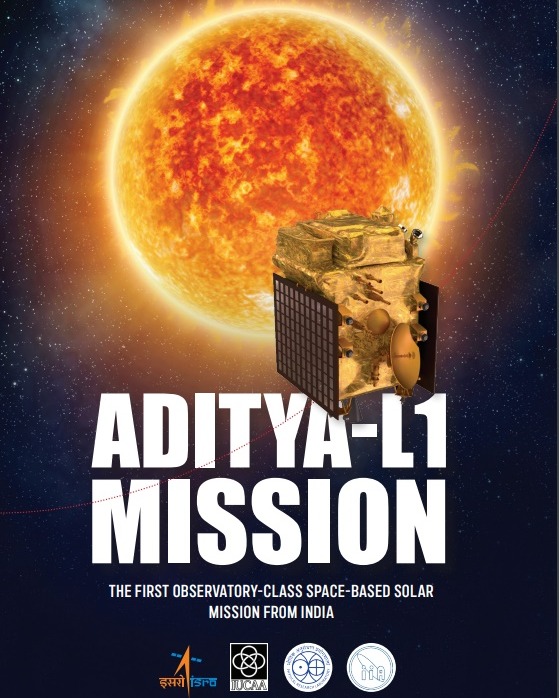
India’s remarkable accomplishments in space exploration continue to ascend as ISRO (Indian Space Research Organisation) prepares to embark on its latest endeavor, the Aditya-L1 mission. Scheduled for launch around September 2, this mission seeks to delve into the mysteries of the Sun from a vantage point approximately 1.5 million kilometers away. Equipped with a suite of instruments, the spacecraft’s mission is to scrutinize various facets of the Sun, unraveling insights into solar phenomena and their impacts on our planet. The launch of Aditya-L1 not only underscores India’s burgeoning competence in space technology but also represents its maiden dedicated mission focused on solar observation.
The Aditya L1 Mission
Anticipate an extraordinary odyssey through space! Aditya L1 embodies India’s pioneering initiative to unravel the enigma of the Sun. Envision a unique location called Lagrange Point 1 (L1), positioned 1.5 million kilometers distant from Earth, where the spacecraft will gracefully orbit.

This strategic orbit affords an unobstructed, front-row view of the Sun’s majesty, akin to a constant front-row seat. This remarkable perspective enables real-time observation of solar activities and their interplay with space weather. Aditya L1 is equipped with a suite of seven instruments, each featuring specialized sensors, tailored to scrutinize distinct segments of the Sun. While some instruments analyze its outer layers, others delve into the Sun’s intricate “magnetic personality.” These endeavors aspire to decode the Sun’s thermal dynamics, unveil the origins of powerful solar outbursts, and unravel a multitude of other celestial phenomena. This mission aptly resembles interstellar detectives dissecting the secrets of our resplendent star.
Aditya L1 Mission Launch Date and Timing
The countdown to the Aditya L1 mission’s monumental launch has commenced. The significant date etched in the calendar is September 2, 2023. On this pivotal day, the specialized spacecraft will initiate its expedition to explore the Sun from its lofty cosmic vantage point. The impending launch unfurls like an eagerly awaited cosmic saga.
Aditya L1 Mission Expenditure
A conversation about fiscal matters beckons! The Aditya L1 Mission was initially estimated to cost around INR 378.53 crores in 2019. However, present-day costs remain undisclosed. The mission’s operational span spans approximately 5.2 years, necessitating funding for the creation of specialized tools and instruments. These sophisticated apparatuses demand substantial financial resources for their fabrication. The budget encompass a spectrum of vital elements, including mission planning, launch logistics, and sundry other essentials. In essence, the budget forms a substantial fiscal reservoir, integral for the seamless execution of the mission’s objectives.
Aditya L1 Mission Goals
The Aditya L1 mission harbors ambitious objectives. Its overarching aim is to unravel the Sun’s enigmas, achieved through meticulous analysis of its upper atmosphere and extraordinary occurrences such as solar eruptions. The mission also investigates the Sun’s particle dynamics and intricate magnetic fields. By probing these phenomena, the mission strives to elucidate the mechanisms behind the Sun’s elevated temperatures, the genesis of solar storms, and the origins of space weather. The spacecraft is equipped with a collection of seven instruments, each resembling a celestial detective, meticulously unraveling the well-guarded secrets of the Sun.
List of Key Goals for the Aditya L1 Mission:
1. Analyze dynamics of the Sun’s upper atmosphere.
2. Comprehend chromosphere and corona heating and eruptions.
3. Probe particles and plasma in solar vicinity for insights.
4. Investigate heating mechanism of the solar corona.
5. Determine properties of coronal plasma: temperature, speed, density.
6. Unveil origins and behavior of coronal mass ejections (CMEs).
7. Identify mechanisms governing solar eruptive events.
8. Examine solar corona’s magnetic field topology and measurements.
9. Trace sources of space weather, including solar wind.
Aditya L1 Model:

The Aditya L1 model serves as a conceptual guide for a specialized spacecraft poised for an extraordinary mission. This spacecraft is primed for an extensive journey aimed at studying the Sun. Positioned at a considerable distance – approximately 1.5 million kilometers away from Earth – it will keenly observe solar activities. The model encompasses all the essential components and tools requisite for the spacecraft’s task.
These tools encompass diverse functions, ranging from capturing distant imagery to conducting meticulous examinations of the Sun’s facets. Notably, the model aligns with the mission’s overarching objectives, including unraveling the Sun’s scorching temperature enigma and comprehending the genesis of solar storms. Essentially, the model furnishes a strategic roadmap that optimally guides the spacecraft’s mission of Sun exploration.
Inside Aditya L1, a conglomerate of seven distinct tools, aptly termed payloads, assumes pivotal roles. These payloads undertake intricate responsibilities that contribute to the mission’s success. Within this assembly, three payloads conduct close-range studies (In-situ), while the remaining four are designed for remote sensing, capturing imagery from afar. Each payload boasts distinct proficiencies, undertaking a variety of scientific tasks.
Payload Name – Capability
1. Visible Emission Line Coronagraph (VELC) – Visualizing the Sun’s corona via imaging and spectroscopy.
2. Solar Ultraviolet Imaging Telescope (SUIT) – Immortalizing images of the Sun’s surface and its atmospheric constituents.
3. Solar Low Energy X-ray Spectrometer (SoLEXS) – Analyzing soft X-rays emanating from the Sun.
4. High Energy L1 Orbiting X-ray Spectrometer (HEL1OS) – Examining hard X-rays emitted by the Sun.
5. Aditya Solar wind Particle Experiment (ASPEX) – Investigating solar wind particles and their kinetic attributes.
6. Plasma Analyser Package For Aditya (PAPA) – Scrutinizing particles and ions in proximity to the Sun.
7. Advanced Tri-axial High-Resolution Digital Magnetometers – Probing the Sun’s intricate magnetic fields.
Aditya L1 Payloads:
Aditya L1 embarks on its mission equipped with a repertoire of cutting-edge tools known as payloads. These payloads are akin to its specialized instruments, designed to decode the mysteries of the Sun. A total of seven payloads are carried, each serving as a unique gadget for solar investigation. Four of these payloads are tailored to observe the Sun from a considerable distance, engaging in tasks like image capture and light measurement to unravel the secrets of its outer layers and sporadic bursts. The remaining trio of payloads adopt an up-close approach, venturing close to the Sun to dissect particles and magnetic fields. In essence, the spacecraft functions as an ensemble of celestial detectives, collectively unearthing the Sun’s concealed truths.
Aditya L1 Mission in a Nutshell:
Aditya L1 constitutes India’s inaugural mission entirely focused on probing the Sun. Its primary aspiration is to delve into the intricacies of solar behavior and its implications for space weather.
Key Launch Date:
The anticipated launch window is set to open around September 2, 2023.
Scope of Aditya L1’s Inquiry:
Aditya L1’s endeavors encompass the investigation of the Sun’s upper atmosphere, mechanisms of heating, eruptive phenomena, magnetic field attributes, and more.
Craft’s Orbital Position:
The spacecraft is poised within a halo orbit encircling Lagrange Point 1 (L1), situated approximately 1.5 million kilometers from Earth.
Payload Portfolio:
The spacecraft boasts an ensemble of 7 payloads, a blend of tools for remote sensing and in-situ analysis, each contributing to a comprehensive understanding of solar dynamics.
Mission’s Goals:
The mission’s overarching objectives revolve around unraveling the intricacies of solar dynamics, eruptions, magnetic fields, and the drivers behind space weather.
Notable Onboard Instruments:
Among the remarkable onboard instruments are the Visible Emission Line Coronagraph (VELC), Solar Ultraviolet Imaging Telescope (SUIT), and an array of others poised to illuminate the Sun’s enigmatic features.





